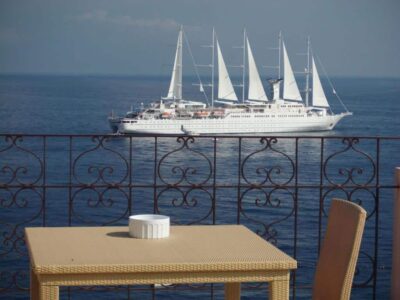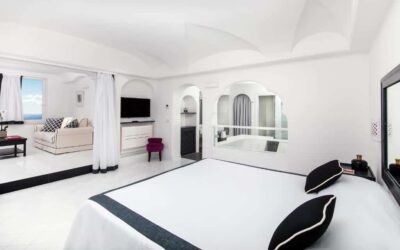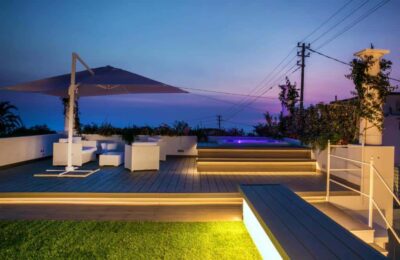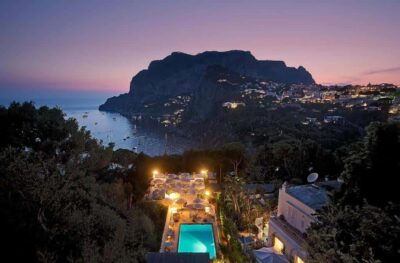The island of Capri, thanks to its marvellous landscapes, its history and above all its glamorous and worldly atmosphere, is certainly one of the most popular travel destinations.
If you too are looking for information about visiting this little paradise on earth, you have come to the right place. In this article we will take you by the hand and virtually travel together through the streets of the island: from the famous Faraglioni rocks, to the beaches, the liveliest and most fashionable areas and the luxurious villas, we will provide you with all the indispensable information you need to organise your itinerary in the best possible way.
If you read the whole article, you’ll find tips and suggestions for planning a multi-day trip to Capri, but if you’ve already booked your trip to the Amalfi Coast or the surrounding areas and are looking for information in view of a quick getaway, we invite you to also read our article dedicated to organizing a day trip to Capri starting from the Amalfi Coast.
Indice dei contenuti
How to get to Capri
Capri can only be reached by sea with hydrofoils leaving from Naples, Salerno and Sorrento.
If you arrive at Rome Fiumicino airport, take the Leonardo Express to Roma Termini. From here, take Regionale, Intercity, Freccia Rossa or Italo to reach Naples or Salerno.
If your first destination is Naples, you can take the boat to Capri from Molo Beverello or Calata Porta di Massa: hydrofoils leave from the former, which are slightly faster, ferries and fast ships leave from the latter.
✅ Alicost hydrofoils to Capri leave from Salerno and also from the Amalfi Coast (from April to November).
Please note that the Alicost company, whose ferries leave from Salerno, Vietri, Cetara, Maiori, Amalfi and Positano, also offers the possibility of buying a return ticket in one go, with a small reduction in the total cost.
✅ From Sorrento, hydrofoils and ferries leave from Marina Piccola: in summer there are runs every thirty minutes or so.
Please note that for most of the year it is not possible for non-residents to disembark with cars and motorbikes, but the good news is that you can do without: the various points on the island are well connected by bus lines and the funicular railway.
Bypass the traffic, embrace the sea! Reserve your ticket
📣 A surprise for you: if you are still in the process of organising your itinerary and are also considering a few stops on the Amalfi Coast, we recommend downloading our free guide “How to get around the Amalfi Coast without stress”. Inside you will find plenty of information on how to organise your travels from one place to another, as well as advice on how to tackle the winding SS163 Amalfitana road, which will come in very handy if you are considering travelling by car.
Where to sleep in Capri
📣 Looking for the perfect accommodation for your next holiday?
We’ve selected the best solutions for you
What to see on Capri
Once you reach Capri’s Marina Grande, you’ll move towards the centre of the island: you can either use the cable railway close to the pier, or the bus, slightly further away. Alternatively, at a cost of about twenty euro, you can travel by taxi.
If you have a lot of suitcases and perhaps want to immerse yourself immediately in the atmosphere of the island, without wasting a second, you can rely on the luggage transport service, which will take care of transporting your suitcases to your accommodation. At this point your exploration of the island will begin, starting from Piazzetta Umberto, the beating heart of Capri.
📍 Piazzetta Umberto
This is the first place you will see after you land on Capri. Here you will be in the heart of the island: a lively little square where important celebrities have strolled and that well sums up the glamorous atmosphere of the island. In the past it was the site of the local market, today it is the meeting point for all those who love the social life.
It is certainly the busiest place on Capri: at certain times of the day it can really seem like a small living room of the world, because an incredible amount of travellers and tourists are concentrated here, not to mention the possibility that there may be some famous personages incognito among them. Time for these moments of relaxation is punctuated by the Clock Tower, the iconic symbol of Capri.
A few steps away from the Piazzetta is the Belvedere di Via Tragara, from where you can admire the Faraglioni of Capri in all their beauty.
If at some point the hustle and bustle of the crowded square should get too much for you, continue first towards the Church of Santo Stefano, the most important church in Capri, designed in 1688 by Francesco Antonio Picchiati, then head towards the Teresiane orange garden: following the typical narrow streets of the island, you’ll reach the oldest part of Capri, where you can enjoy more peace and quiet.
One thing to know: a drink at the crowded tables of bars and clubs is certainly more expensive than the average in other places: a coffee, for example, costs around €5.
📍 The Blue Grotto
One of the most famous attractions on the island is certainly this cave, where the water takes on a very special blue colour with silvery reflections. Another peculiarity is the way it is accessed: the entrance is only one metre high, so only small boats with a maximum capacity of four people can pass through. The driver of the boat asks the passengers to duck down near the entrance and launch himself inwards using a chain attached to the rock.
Bathing inside the cave is prohibited, mainly because the number of boats coming and going makes it very dangerous.
The cave is open every day in summer, from 9am to 5pm, but only if the weather conditions are favourable. The advice is to visit on sunny days, to enjoy the reflection of the water, which is less visible in cloudy skies.
📣 A word of caution: During the afternoon hours, the sea may be rough and therefore entry to the cave may be prohibited.
To reach the Blue Grotto you can take the bus from Anacapri or the boat from Marina Grande. You can also reach it by private boat, informing the boatmen that you would like to visit the cave. Alternatively, private tours depart from Marina Grande on boats
📍 The scenic spot for photographing the Faraglioni
A short walk from Anacapri’s bus stop, you’ll find the Monte Solaro cable car: from here you can enjoy a panoramic view of Capri from above. Once you’ve reached your destination, you’ll find a viewpoint from which to contemplate the panorama and take beautiful photographs. For the return journey you can proceed on foot and stop along the way to visit the Eremo di Cetrella, a small church located in the homonymous town of Anacapri. The church can be visited during the summer period.
📍 Anacapri
On the slopes of Monte Solaro in the upper part of Capri lies the town of Anacapri, where you can get away from the crowds in the centre of the island and take a leisurely stroll through the delightfully flower-adorned streets.
Here, remember to visit Villa San Michele, once the residence of the doctor and philosopher Axel Munthe: the interior spaces and the garden with panoramic views are marvellous.
Also worth a visit is the Church of San Michele, interesting for its splendid majolica floor, the work of Leonardo Chiaiese.
Another must-see is La Casa Rossa (The Red House), another historic residence, which stands out for its Pompeian red exterior walls and different architectural styles: inside, you can admire a permanent exhibition that offers splendid visions of Capri and its everyday life in the 19th and 20th centuries, through works by famous artists such as Casciaro, Montalant, Vianelli and Hay.
To reach Anacapri you can travel by bus from Capri or take the funicular railway from Marina Grande to Capri and then continue by bus.
📍 Villa Jovis
On the eastern side of the island of Capri you will find this Villa, one of 12, that the Emperor Tiberius had built on the island.
Villa Jovis is the largest of the villas and is located in a position, on top of Monte Tiberio, that allows the view to embrace the Gulf of Naples, the island of Ischia and Punta Campanella.
The villa is open from Thursday to Sunday and can be reached from the piazzetta with a pleasant walk of about 40 minutes.
On the way to the Villa di Tiberio, we also recommend a stop at the Parco Astarita, a garden less known to tourists and with free admission.
📍 The Gardens of Augustus and the Charterhouse of San Giacomo
From Piazza Umberto I, proceeding first on Via Vittorio Emanuele, then on Via Serena and finally on Via Matteotti, you’ll reach the marvellous Gardens of Augustus, where you’ll walk along splendid flowering terraces offering a spectacular view of the Faraglioni of Capri and the bay of Marina Piccola.
On the way to the Gardens of Augustus, turn left into Via Serena and take Via Certosa, to reach the Certosa di San Giacomo, the oldest monastery in Capri – dating back to 1371 – during the summer months the venue for events and concerts.
What to do in Capri
Trekking and hiking
Although in the collective imagination Capri is associated with the sea and a lively social life, in reality the island offers many wonderful experiences in contact with splendid nature.
In this section we will provide you with information on how to organise healthy walks to discover the more authentic and less touristy side of this enchanting treasure chest!
📍 The Phoenician staircase
this is the staircase that connects Marina Grande with Anacapri. Almost a thousand steps that will take you to the upper part of the island, near the Church of San Michele, which we mentioned in the previous section and which we recommend you visit.
Once you reach your destination, you will be able to admire the entire island from above. There is no shortage of enchanting views to admire along the way: the walk would take about an hour, proceeding at a leisurely pace, but we advise you to slow down and enjoy a healthy slow walk, with the intention of savouring the pleasantness of nature and the landscape. In short, stress-free, the way we like it.
You can reach the beginning of the Scala Fenicia by taking via palazzo mare, less than 400 metres from the port: from here you will find signs indicating the start of the route.
📍 Monte Solaro… on foot
we have already mentioned Monte Solaro, to be reached to enjoy a view that allows you to embrace the entire island of Capri. In the previous paragraph we advised you to take the funicular, in this case, we suggest you reach Monte Solaro on foot. The route starts from Piazza Vittoria (Anacapri), the same stop as the funicular. The route is simple: walk straight ahead and in about an hour you will reach the top of the mountain.
📍 Sentiero dei Fortini
this walk starts from the Grotta Azzurra and runs along the sea to the Punta Carena lighthouse. Along the way you can admire the three forts – Orrico, Pino and Mesola – that were built in 1806 by the British to protect the island. The walk can also be taken in the opposite direction, i.e. from Punta Carena to Grotta Azzurra, and takes about three hours.
📍 The Pizzolungo Walk
starting from Capri’s Piazzetta, take this path that winds through the green vegetation and blue sea and leads away from the crowds in the centre of the island. Along the way you will come across “House Like Me”, a luxurious villa built by the writer Curzio Malaparte. The end point of this route is the Punta Tragara belvedere, from where you can continue along a path leading to the foot of the Faraglioni.
Experiences you can only have on Capri
📣 Looking for unforgettable experiences on Capri?
We’ve carefully chosen the experiences you can’t miss!
Once you’ve arrived on Capri, we recommend you carve out as much time as possible to relax, unwind and enjoy the island’s lively atmosphere. Here, you can choose, depending on the mood of the moment: if you prefer to throw yourself into the crowded centre, teeming with tourists and visitors from all over the world, you will find Piazza Umberto, the world’s living room, waiting with open arms for an aperitif or a coffee. If you want to feel like a VIP, go shopping in Via Camerelle.
If, on the contrary, you are looking for more tranquillity, Anacapri will offer you more silence and peace.
Don’t forget to add some unmissable experiences to your bucket list: a leisurely walk, a tour of the island by boat and a visit to the Grotta Azzurra.
In the next section we’ll add another piece to the must-do experiences on Capri: enjoying the sea and the most beautiful beaches!
Capri’s beaches
📣 Imagine: you can swim in crystal clear water, admiring the iconic Faraglioni!
If you’re one of those people who, when you think of summer, visualise themselves sprawled out under a beach umbrella from morning till sundown, read this section carefully, where we’ll take you on a tour of the island’s beaches.
Before proceeding, however, we warn you that Capri’s beaches are small and, as you can imagine, very crowded during peak periods. Often, as you will see, they are not real beaches, but rocky terraces, which require walking along paths or long stairways to reach them. Take this fact into account when choosing which footwear to pack.
✅ Marina Grande beach: the largest beach on the island, not far from the pier where the boats dock. This is the favourite beach for families with children because it offers bathing facilities and is very central. The beach is equipped to accommodate people with disabilities.
✅ Palazzo a Mare: in the Marina Grande area, accessible by sea or via a path, you will find this small pebbled beach, which offers a free area and an equipped area. Marina Piccola beach: the view of the Faraglioni makes this beach one of the most beautiful on Capri and probably one of the most sought-after. The beach is equipped, but you can reach the free beaches, which are on either side, by taking the steps from the Marina Piccola stop.
✅ At the foot of the Faraglioni: another very suggestive place to bathe. In practice, you’ll be sunbathing on the rocks at the foot of Capri’s Faraglioni rocks. You can reach it from the small road that starts from the Punta Tragara viewpoint, which we told you about in the previous paragraph. This area is served by two bathing establishments, which also have a restaurant. Again, this is a particularly sought-after place, so it is worth booking. We advise you to prefer it if you are an expert swimmer, because the water is deep and you can access the sea via a ladder.
✅ The Punta Carena Lighthouse: this area is less touristy, in fact it is the favourite location of the Capresi. Incidentally, it is the spot where the sun sets later than the other beaches. You will not be on a real beach, but on rock terraces, one of which is equipped and served by bathing establishments, while the other is free and has two bars.
Events on Capri
✅ The feast of San Costanzo: the patron saint of Capri is San Costanzo, the warrior saint, protector of the coast from invasions by raiders. Every year, on 14 May, he is celebrated with a solemn Procession through all the streets of the centre. The feast day is felt with devotion and love by all the island’s inhabitants, who join in the celebrations with strong participation. The custom is to throw rose petals and broom from windows. There is also the contribution of the local band to amplify the festive atmosphere. At the end of the procession, the celebrations move to the Marina Grande area, where, amidst the colours, music and festive crowds, the evening is spent browsing through the various sweet stalls.
Why choose Capri as your holiday destination
An island that offers mundane life and beautiful scenery at the same time: Capri is a true jewel of the Mediterranean, a travel experience to be had at least once in a lifetime.
Capri is the ideal destination for those who are planning a dream trip and want to feel like VIPs for a few days, with the possibility of actually meeting some famous people, perhaps during an aperitif in Piazza Umberto.
📣 Choose Capri if:
🔹 You are looking for a romantic destination for an unforgettable couple’s trip.
🔹 You are looking for a destination that allows you to move from the chaos of the crowded social life to the tranquillity of the quietest and most secluded walks.
🔹 You are looking for sea, sun and relaxation, but also the chance to enjoy a good nightlife.
🔹 You are not afraid of crowded beaches and clubs.
The best time to visit the island of Capri
The best time is between late spring and early summer, when the amount of travellers, tourists and commuters is not at its peak.
In this period, you also find a more pleasant and mild climate, which allows you to enjoy both the sea and the walks to discover the island.
Remember that swimming is possible as early as May. In fact, between May and June you will find the beaches less crowded and the climate much more favourable for those who want a flawless tan.
If the sea is not a priority, you can also choose the low season, i.e. the months of March, April and October. During this period, prices are much lower and you can enjoy the island, its quiet and relaxed atmosphere and a decidedly slow holiday.
Should you wish to travel in the winter months, perhaps with the intention of savouring the authentic island life, we advise you to bear in mind that from November to March almost all hotels and clubs are closed, with the exception of a few B&Bs and a few bars open for locals.
📣 Small clarification: certainly when one thinks of Capri, the first idea that comes to mind is that of its piazzetta packed with travellers and tourists. This is largely true: Piazza Umberto is the square where crowds, chaos and social life are concentrated. However, you should know that towards evening, when the ferries leave again, the island becomes quieter and much less crowded.
Curiosities about Capri
✅ The Capri blue lizard: this is a species of lizard – Podarcis siculus coeruleus – that inhabits the Faraglioni of Capri. Its characteristic feature? Its colour! The reptile, in fact, is a particularly intense blue. This lizard actually also lives in other naturalistic contexts, but the one on the Faraglioni is said to have a more intense colour.
✅ The Island of the Sirens: the island of Capri is also called the ‘Island of the Sirens’. This appellation is due to the Siren rock in the bay of Marina Grande. Apparently, Virgil, in Canto V of the Aeneid, provided the inspiration for this tradition, speaking of creatures half-woman and half-fish that supposedly inhabited the island of Capri. As we know, these mythological creatures bewitched sailors with their singing, causing them to crash against the rocks.
✅ The Grotta Oscura: it is said that there was a cave on Capri that was larger than the Grotta Azzurra. The entrance to this first rocky cavity is said to have been closed off by a rocky ridge in 1808. Over the years, attempts have been made to bring the Grotta Oscura back to light, to no avail.
History
Some erudite person who came to Capri in the 18th century gave the suggestive name of ‘Scoglio delle Sirene’ (Siren’s Rock) to the rocky outcrop rising in the bay of Marina Grande. He was probably familiar with the Greek myth of the Sirens, which characterises the history of Capri, Sorrento and, more generally, the Gulf of Naples.
The first communities on Capri were Greek after the 8th century BC.
However, it should be noted that at that time all political and economic life revolved around Cumae and that Capri was of secondary importance.
In Roman times, however, the role of the island of the Sirens was much more important. A significant date, albeit one with legendary contours, is 49 BC, when Caesar Octavian landed there. According to tradition, an old oak tree showed signs of life, which Octavian interpreted as a sign, deciding to free Capri from the domination of Naples, giving the island of Ischia in exchange.
Capri became the favourite home, first of Augustus, then of Tiberius, his successor, who established his permanent residence here, moving from imperial Rome and having as many as 12 villas built here, including Villa Jovis and Palazzo a Mare, which we have told you about in this article.
Initially, Tiberius liked the particular conformation of Capri, which, with no access from the sea, was practically unassailable. However, the need to remain in contact with the fleet of Miseno convinced him to build the Port of Marina Grande.
It should be noted that, from the discovery of some archaeological finds, it is assumed that the port of Marina Grande dates back to the previous Augustan epoch.
Once the Imperial Age was over, Capri returned under the wing of the Neapolitan State, and then came under the rule of Amalfi.
Amalfi’s frequent contacts with the Arab and Byzantine world brought these artistic influences to Capri as well, which are still evident in some classical, Byzantine and Islamic elements, evident in some sacred buildings: this is the case of the heterodox barrel vaults of the Church of Santo Stefano.
After a long period of Arab raids, during which the inhabitants moved from Marina Grande to the higher ground, Capri had with the Angioni its first lord embodied by Count Arcucci.
The division between ‘marine’ and mountain Capri, present since the Greek settlement, continued to exist even in the Middle Ages: the distinction between Capri and Anacapri implicitly sanctioned the presence of two islands in one.
The gap between the two ‘islands’ was bridged during the Spanish Reign, in 1496, when Frederick I of Naples established parity between Capri and Anacapri, establishing the separation of administrations and annuities.
Subsequently, the island of Capri became part of the Principality of Salerno: from this moment on, until the conquest by France in 1830, raids and raids by pirates continued, until Charles V was forced to authorise the islanders to go armed.
It was during this period that Jean Jacques Bouchard, an ante-litteram tourist from Capri, arrived on the island. He has left us a priceless testimony: his diary, which carefully describes Capri’s landscape and cultural characteristics, with an impressive amount of detail, if we think that he only stayed on the island for two days.
Among the rulers of the Bourbon era, those who showed the greatest interest in Capri were Charles III and Ferdinand IV: in fact, during this period, archaeological research was greatly stimulated, which brought to light the above-mentioned Villa Jovis.
During the 19th century, the war between Napoleon and England also involved Capri: during these years, the British established some garrisons here, causing some damage to important imperial ruins.
It was Joachim Murat who annihilated the English forces in 1808.
The French remained here until Ferdinand IV of Naples returned to Naples and under the name Ferdinand I, became ruler of the Kingdom of the Two Sicilies.
Slowly Capri became the destination of many travellers who visited it and admired its nature and the famous Blue Grotto, which had meanwhile become world famous.










